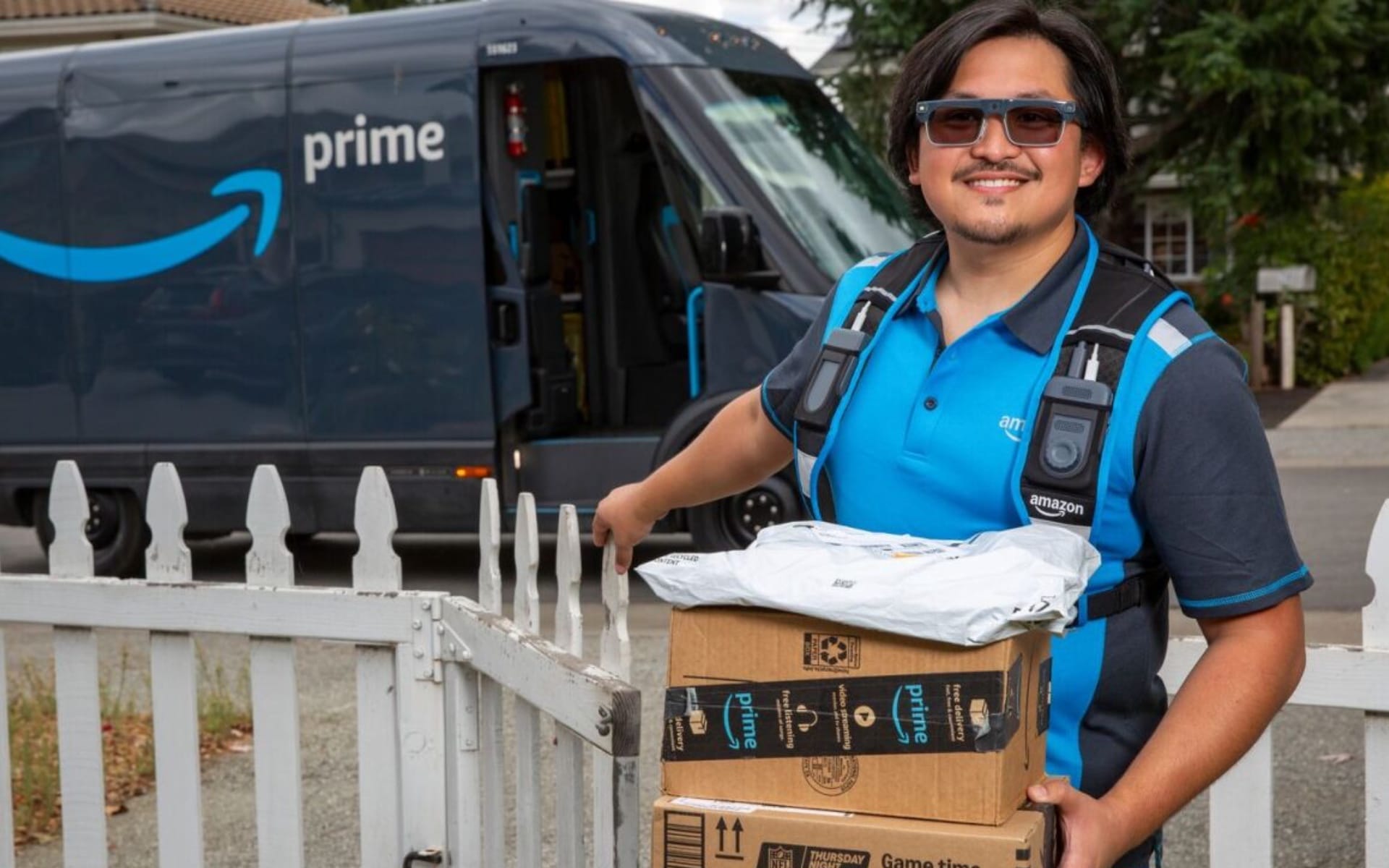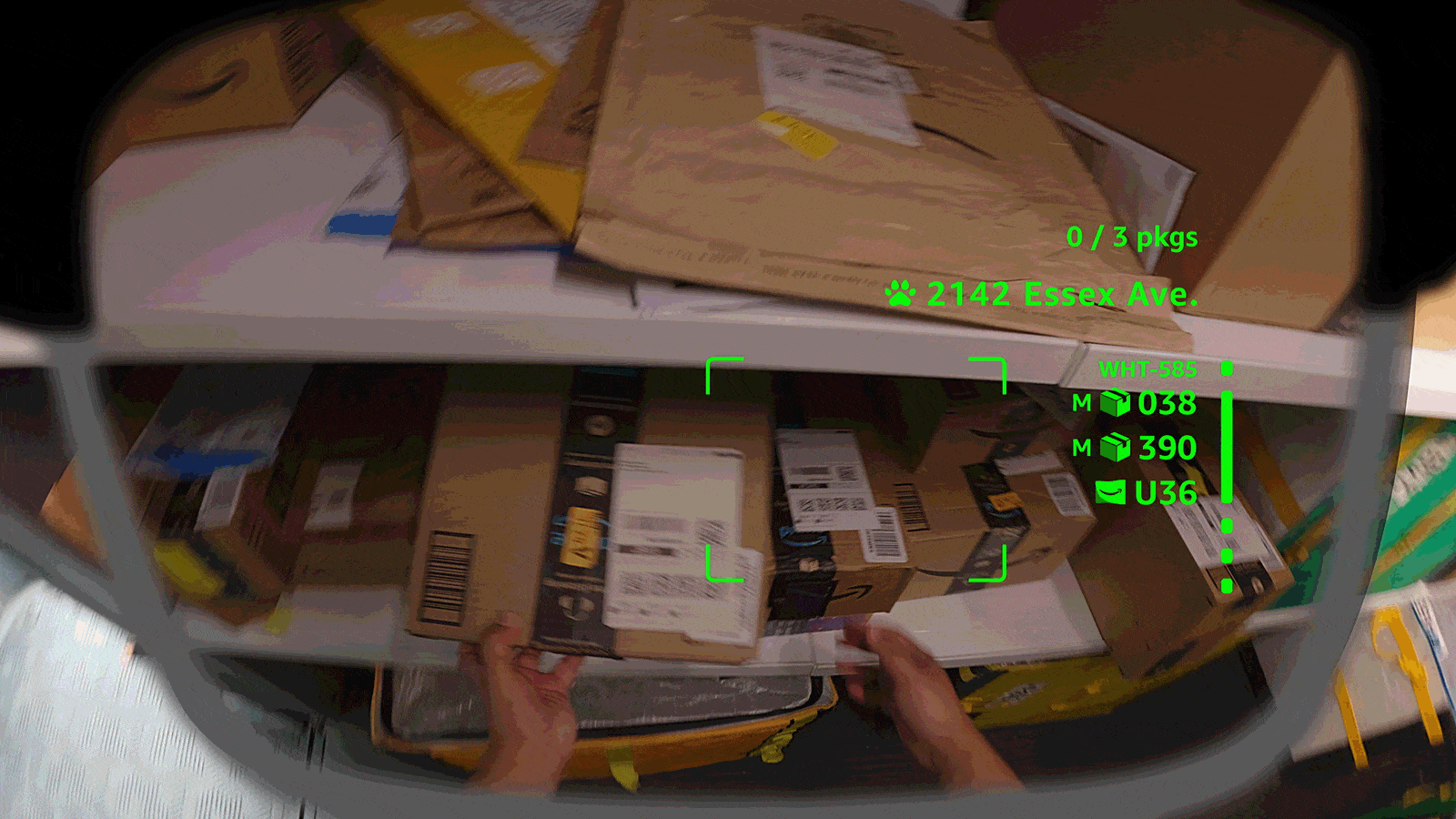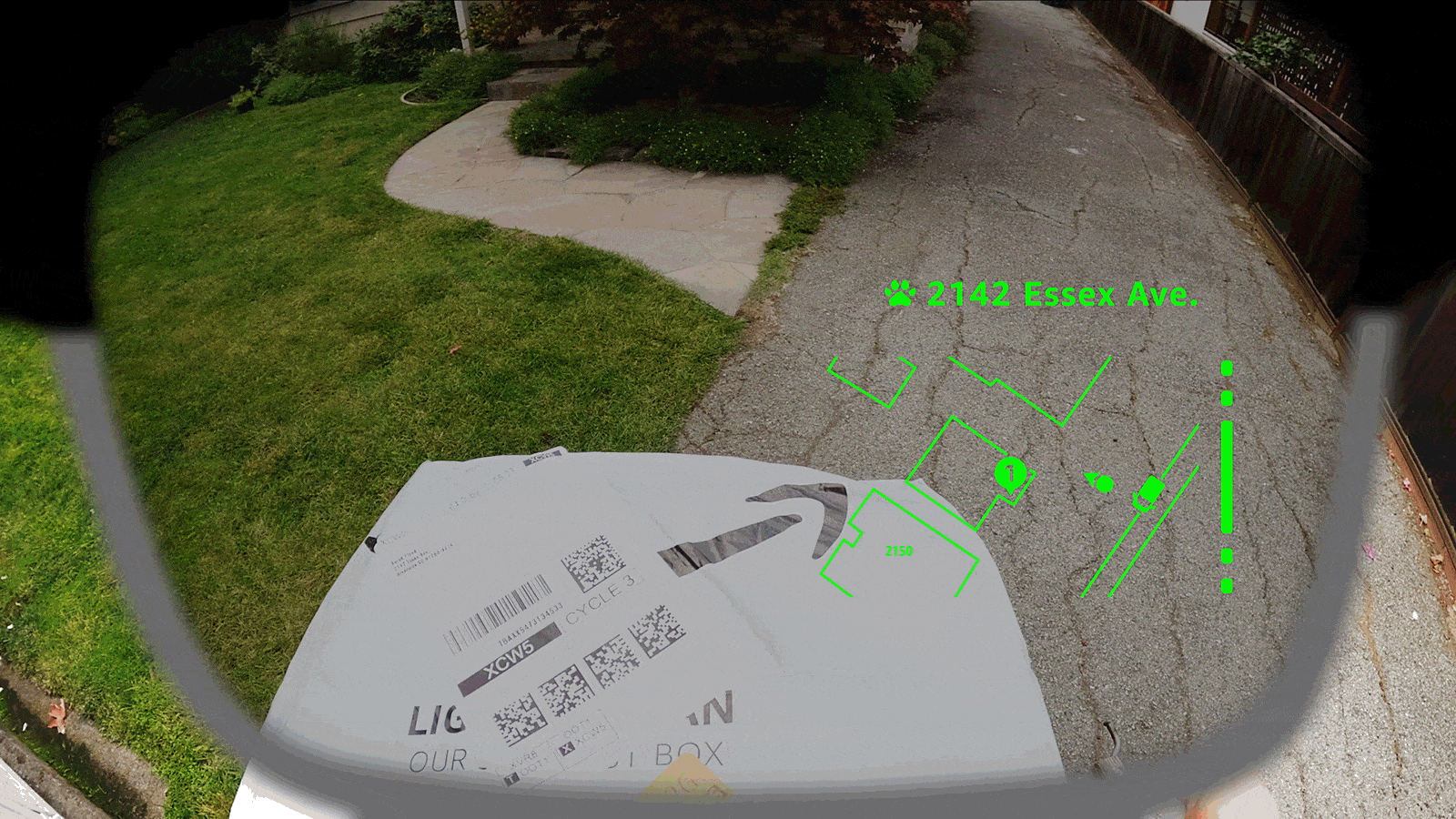Amazon develops smart glasses for delivery drivers with AI-powered tracking
Amazon announced smart delivery glasses on October 22, 2025, using computer vision and AI to monitor drivers while building datasets for automation.

Amazon unveiled smart delivery glasses designed specifically for its delivery workforce on October 22, 2025. The announcement describes wearable technology that displays navigation instructions and package information directly in drivers' field of view, eliminating the need to check mobile devices during deliveries.
The glasses incorporate computer vision processing and AI integration to scan packages, provide turn-by-turn walking directions, and capture proof of delivery photos. A small controller worn in the delivery vest contains operational controls, a swappable battery, and an emergency button for reaching emergency services. The devices support prescription lenses and transitional lenses that automatically adjust to lighting conditions.
The technology arrives as internal strategy documents reveal Amazon's broader automation agenda. According to documents viewed by The New York Times on October 21, 2025, Amazon's automation team expects to avoid hiring more than 160,000 people in the United States by 2027. Executives informed the board in 2024 that robotic automation could enable the company to maintain its current U.S. workforce size even while doubling sales volume by 2033, translating to more than 600,000 positions that would not need to be filled.
Subscribe PPC Land newsletter ✉️ for similar stories like this one. Receive the news every day in your inbox. Free of ads. 10 USD per year.
Computer vision capabilities expand monitoring scope
The smart glasses leverage AI-powered sensing capabilities to create a heads-up display showing navigation details, hazards, and delivery tasks. When drivers park at a delivery location, the glasses automatically activate and display delivery information starting with package location inside vehicles through to corresponding destination homes.
Future versions will provide real-time defect detection capabilities. The glasses will notify drivers if they've mistakenly dropped a package at a customer doorstep that does not correspond with the house or apartment number on the package. The system will detect hazards including low light conditions and adjust the lenses accordingly, notify wearers about pets in yards, and provide additional safety warnings.

Amazon developed the glasses with input from hundreds of Delivery Associates who work for Delivery Service Partners. Kaleb M., a DA working for Maddox Logistics Corporation in Omaha, Nebraska, explained during testing that the glasses provided safety benefits by keeping information in his field of view rather than requiring him to look down at a phone.

The devices create continuous data streams from delivery operations. Every package scan, navigation step, hazard detection, and proof of delivery photo generates data points that feed into Amazon's systems. This data collection occurs across millions of daily deliveries as the technology scales across the delivery network.
Automation strategy targets 75 percent of operations
Documents show Amazon's robotics team maintains an ultimate goal to automate 75 percent of its operations. The company opened its most advanced warehouse in Shreveport, Louisiana, last year as a template for future robotic fulfillment centers. The facility employs a thousand robots and required a quarter fewer workers than it would have without automation.
Amazon plans to replicate the Shreveport design in approximately 40 facilities by the end of 2027, beginning with a warehouse that opened in Virginia Beach. The company has also begun retrofitting older facilities, including one in Stone Mountain near Atlanta. That facility currently employs roughly 4,000 workers but is projected to process 10 percent more items while needing as many as 1,200 fewer employees after robotic systems are installed.
The Stone Mountain retrofit will result in fewer full-time employees and increased dependence on temporary staff. Employees working on the transition have strategized ways to "control the narrative" in Georgia by focusing on new technician jobs and innovation to give local officials a sense of pride.
At the Shreveport facility, more than 160 people work as robotics technicians earning at least $24.45 per hour. Most of the 2,000 employees are regular hourly workers whose pay starts at $19.50. Udit Madan, who leads worldwide operations for Amazon, said the company has a long history of using savings from automation to create new jobs, pointing to recent expansion of delivery depots in rural areas.
The pandemic's surge in online shopping sent Amazon on a hiring spree that more than tripled its U.S. workforce since 2018 to almost 1.2 million employees. In March 2024, when executives presented automation plans to the board, directors pressed them to do more with less. By fall, the robotics team had reduced the automation plan cost to less than $10 billion while increasing expected savings to $12.6 billion from 2025 to 2027.
Buy ads on PPC Land. PPC Land has standard and native ad formats via major DSPs and ad platforms like Google Ads. Via an auction CPM, you can reach industry professionals.
Strategic messaging avoids automation terminology
Documents show Amazon has considered building an image as a "good corporate citizen" through greater participation in community events such as parades and Toys for Tots. The materials contemplate avoiding terms like "automation" and "A.I." when discussing robotics, instead using phrases like "advanced technology" or replacing "robot" with "cobot," which implies collaboration with humans.
Kelly Nantel, a spokeswoman for Amazon, said the documents viewed by The Times reflected the viewpoint of one group inside the company. She noted that Amazon planned to hire 250,000 people for the coming holiday season, though the company declined to specify how many of those roles would be permanent. Amazon also stated that it's not insisting executives avoid certain terms and that community involvement is unrelated to automation.
The smart glasses announcement made no reference to how delivery data might be used for AI training or automation development. However, Amazon's pattern of data utilization across its operations suggests potential applications. The company blocks AI bots from external companies while developing its own AI tools across multiple business units.
In August 2025, Amazon added six AI-related crawlers to its robots.txt file, targeting bots from Meta, Google, Huawei, Mistral, and other technology firms. The retailer explicitly disallows OpenAI's crawler and blocks AI bots from Anthropic, Meta, and similar companies. The platform uses rigorous bot-detection including fingerprinting and AWS WAF to prevent automated scraping.
Juozas Kaziukėnas, an independent analyst who spotted the August restrictions, noted that Amazon is "definitely not interested in helping anyone build the future of AI shopping. If that is indeed the future, Amazon wants to build it itself."
Marketing implications extend beyond logistics
For the digital advertising community, Amazon's delivery glasses development signals expanding data collection capabilities that feed into the company's advertising infrastructure. Amazon's advertising revenue reached $15.7 billion in Q2 2025, representing 22 percent year-over-year growth driven by AI-enhanced targeting and campaign optimization.
The company's AI capabilities span multiple aspects of advertising delivery, from targeting optimization to creative enhancement. Amazon's vast first-party data ecosystem, combined with advanced machine learning models, creates competitive advantages in audience identification and campaign optimization.
Amazon introduced agentic AI capabilities across its seller platform on September 17, 2025, transforming marketplace management from passive assistance to active business partnership. The enhancement enables sellers to collaborate with an intelligent assistant that monitors accounts, optimizes inventory, and manages advertising campaigns around the clock.
The system operates through Amazon Bedrock, leveraging Amazon Nova and Anthropic Claude foundation models combined with Amazon's 25-year experience supporting marketplace sellers. This infrastructure enables the AI to monitor account health, optimize inventory, and anticipate seller needs while developing strategic solutions for business growth.
Data collected from delivery operations could enhance Amazon's understanding of delivery patterns, neighborhood characteristics, and customer behavior. This information potentially feeds into advertising targeting, logistics optimization, and marketplace operations.
Daron Acemoglu, a professor at the Massachusetts Institute of Technology who studies automation and won the Nobel Prize in economic science in 2024, said Amazon has unique incentives to automate. "Nobody else has the same incentive as Amazon to find the way to automate," Acemoglu observed. "Once they work out how to do this profitably, it will spread to others, too."
If the automation plans succeed, Acemoglu said, "one of the biggest employers in the United States will become a net job destroyer, not a net job creator."
The smart glasses currently lack a specified release date for broader deployment. Amazon has not announced plans for consumer-focused versions, though reports from The Information suggest a consumer product codenamed Jayhawk is under development. That device would also include a screen, according to the reports.
Amazon's delivery infrastructure continues expanding alongside automation efforts. The company introduced Add to Delivery functionality on October 2, 2025, enabling Prime members to add items to upcoming deliveries with a single tap. The feature requires real-time coordination between inventory systems, warehouse operations, and transportation routing across hundreds of fulfillment centers.
The convergence of delivery automation, AI development, and advertising infrastructure positions Amazon to control multiple aspects of commerce and logistics. The smart glasses represent one component of this integrated system, collecting operational data while potentially reducing long-term labor requirements.
Subscribe PPC Land newsletter ✉️ for similar stories like this one. Receive the news every day in your inbox. Free of ads. 10 USD per year.
Timeline
- 2012: Amazon pays $775 million to acquire robotics maker Kiva, launching its first major robotic automation push
- 2018: Amazon launches Delivery Service Partner program to support delivery workforce
- March 2024: Amazon executives present automation plans to board, with directors pressing for increased efficiency
- Fall 2024: Robotics team reduces automation plan cost to less than $10 billion while increasing expected savings to $12.6 billion from 2025 to 2027
- August 21, 2025: Amazon adds six AI-related crawlers to robots.txt file, blocking Meta, Google, Huawei, and others from accessing e-commerce data
- September 17, 2025: Amazon announces agentic AI capabilities across seller platform, transforming marketplace management with autonomous assistance
- October 2, 2025: Amazon launches Add to Delivery feature for Prime members to add items to upcoming deliveries
- October 21, 2025: The New York Times reports on internal Amazon documents revealing plans to avoid hiring more than 600,000 workers through automation by 2033
- October 22, 2025: Amazon announces smart delivery glasses with AI-powered computer vision for delivery workforce
Subscribe PPC Land newsletter ✉️ for similar stories like this one. Receive the news every day in your inbox. Free of ads. 10 USD per year.
Summary
Who: Amazon's delivery workforce and automation team. The smart glasses target Delivery Associates who work for Delivery Service Partners, representing a workforce that has grown to nearly 1.2 million employees in the United States since 2018.
What: Smart delivery glasses incorporating computer vision and AI integration that display navigation instructions, package information, and hazard warnings directly in drivers' field of view. The technology collects continuous data streams from delivery operations while Amazon pursues broader automation goals targeting 75 percent of operations.
When: Amazon announced the smart glasses on October 22, 2025, one day after The New York Times reported on internal documents revealing automation plans to avoid hiring more than 600,000 workers by 2033. Development involved testing with hundreds of drivers, with no specified timeline for broader deployment.
Where: The technology launches across Amazon's U.S. delivery network, which processes millions of daily orders across hundreds of fulfillment centers. Development coincides with warehouse automation efforts including the Shreveport, Louisiana facility that serves as a template for approximately 40 future locations through 2027.
Why: Amazon frames the glasses as safety and efficiency tools for delivery drivers, enabling hands-free operation while navigating to customer doorsteps. Internal documents indicate the technology fits within broader automation strategies to reduce workforce growth while doubling sales volume, with potential applications for AI training and operational optimization across logistics and advertising infrastructure.

